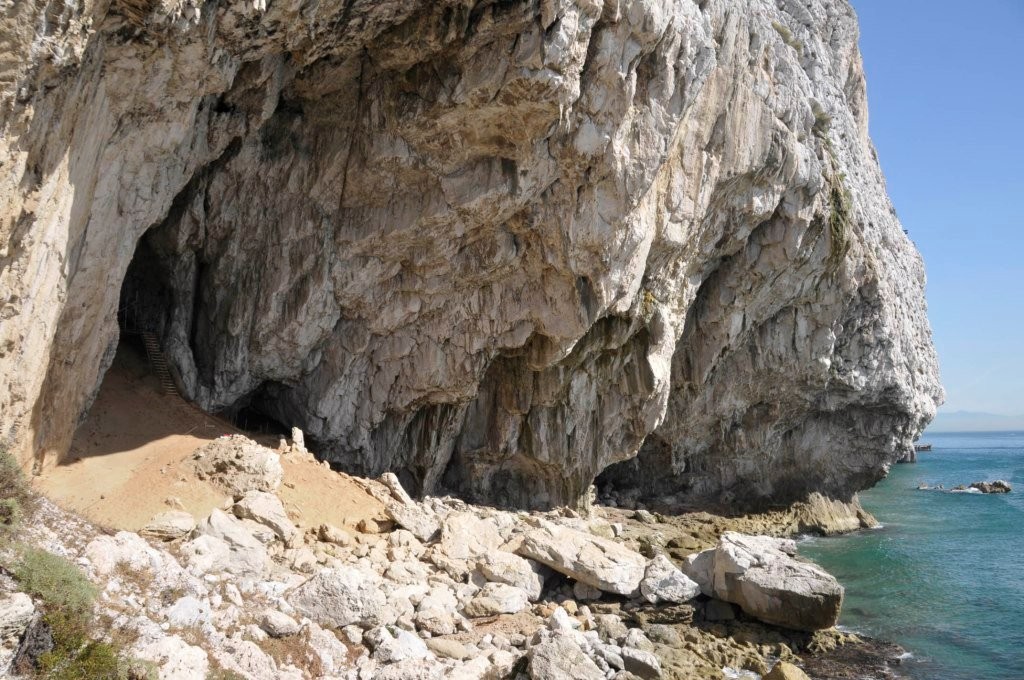The First Complex Structure for the Extraction of Tar was Made by Neanderthals in Vanguard Cave, Gibraltar, 60,000 Years Ago
A scientific study, published today in the journal Quaternary Science Reviews, has described for the first time, a structure which was used by Neanderthals in Gibraltar, 60,000 years ago. This structure, in the form of a pit dug into the ground at Vanguard Cave, would have been used to extract plant resins. The results are highly significant in that they reveal complex levels of cognition in Neanderthals, indicating that they understood the plants that they needed to select and the complex industrial process required in order to manufacture tar.
Neanderthals utilized tar obtained from woody plants as an adhesive for the hafting of stone points onto wooden shafts, making spears for use in ambush - hunting prey. Until now, how they actually obtained the tar necessary for hafting was unknown. Theoretical studies had proposed two methods by which this tar could have been made. One method was simple and of low productivity: it involved the combustion, in the open air, of birch bark. A second, more complex, method would have needed the anoxic heating of fragments of woody plants, such as birch. This second method required that fragments of woody plants would have been buried and heated with fire, isolated from oxygen, so that they would exude resin without the wood catching fire. Which of the two methods was used had great implications regarding the Neanderthals’ cognitive capacities, as the more complex method required a high level of organization and practice.
The results of the present study support theoretical predictions regarding the use of the anoxic heating method. The structure that was discovered in Vanguard Cave resembles a simple hollow in the cave sediment and its simplicity may explain why such structures may not have been recognised in the past. It is only now, after a wide range of analyses involving the collaboration of an interdisciplinary team, that it has been possible to show the pit’s use as a chamber for anoxic heating.
The hearth structure published in this paper was discovered during excavations in Vanguard Cave, Gibraltar. This cave is part of the Gorham’s Cave Complex, which was inscribed as a UNESCO World Heritage Site, as part of the United Kingdom’s list of sites, in 2016. Vanguard Cave has shown, once again, that its peculiar environmental conditions - the result of the rapid advance of a sand dune which sealed the material evidence - have allowed the unique conservation of instant snapshots of Neanderthal activities.

The research was undertaken under the direction of the Gibraltar National Museum, who are responsible for the World Heritage Site, in collaboration with the University of Murcia and the Instituto Andaluz de Ciencias de la Tierra (CSIC). In all, the study needed the participation of a group of 31 scientists from six countries and involved over 15 different disciplines, including palaeobotany, archaeology, ichnology, geochemistry, mineralogy and ecology in order to show that the structure could only have been made by Neanderthals some 60,000 years ago.
Different methods were used to confirm the function of the structure. They included an archaeological experiment which showed that the pit, including its dimensions, were compatible with the extraction of tar. It seems, from the results obtained, that the tar was extracted from gum rockrose (Cistus ladanifer) instead of birch. Birch would have been a rare tree in these Mediterranean latitudes whereas rock roses would have been abundant. It is worth noting that the labdanum obtained from these rock roses has been used in perfumes, as cough mix or even as an antiseptic until the 20th Century.
It was fortunate that the rapid advance of the sand dune 60,000 years ago facilitated the 'sealing' of the structure, with excellent preservation of pollen grains and spores, which have allowed confirmation of the ecological conditions outside the cave at the time. The Neanderthals’ hunting ground was located on the, now-submerged, coastal shelf off the eastern side of Gibraltar and stretched for up to 4.5 kilometres from the caves. It has been previously described as a “Mediterranean Serengeti”. It consisted of a system of sand dunes with scattered stone pine woodland and copses of Mediterranean vegetation and seasonal lakes. It attracted a diverse fauna that included red deer, ibex, wild horse, aurochs (ancestral cattle) and wild boar. The Neanderthals would have hafted their carefully-crafted stone points (typically made from flints and quartzites) onto wooden shafts, using the tar that they had produced, turning them into lethal weapons that they used to ambush-hunt these animals. They may have also used them in defence against the many dangerous predators that roamed this ancient landscape – lions, leopards, spotted hyaenas, wolves, and brown bears.
The Minister for Heritage, the Hon John Cortes said "The Gorham’s Cave Complex continues to receive international recognition and this scientific study offers a fascinating insight into the cognitive development of Neanderthals. This is yet another example of the excellent work being carried out by the Gibraltar National Museum."
Published: November 11, 2024
Other similar News
News
The #IceAgeEuropenow touring photographic exhibition arrives in Gibraltar
Published: March 16, 2019
18-20 Bomb House Lane
PO Box 939,
Gibraltar
